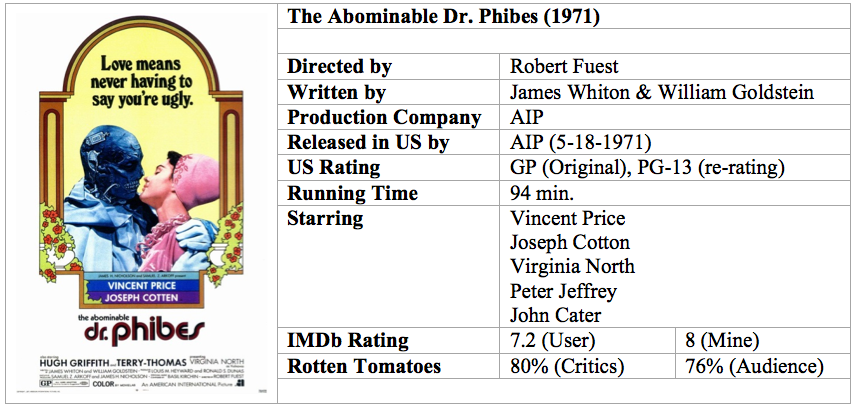Like Frankenstein Must Be
Destroyed, I don’t remember the first time I saw The Abominable Dr.
Phibes. I do, however, remember the
commercial for a television airing on CBS.
Over and over again, I watched a clip where a small airplane crashes and
a crazed Vincent Price, who watches from the hillside, spins a brass
telescope. It’s not the best of the
eight deaths Price orchestrates in the movie, but I guess it safely advertised
the movie for all audiences.
In its entirety, The
Abominable Dr. Phibes is sublime in its simplicity. It’s one of those movies that you can
summarize in one sentence: Dr. Anton
Phibes (Price) seeks revenge on the nine doctors he considers responsible for
his wife’s death. That’s it. The structure built on top of this foundation
is clever and infinitely entertaining:
Phibes is inspired in his revenge by the Ten Plagues of Egypt from the
Old Testament.
In a way, it’s a precursor
to movies like Happy Birthday To Me, Final Destination and Saw, where the
creative deaths are the stars of the show.
What elaborate murder will Phibes engineer next? But The Abominable Dr. Phibes has something
those movies don’t: Vincent Price. Although monstrous and obviously insane, his Phibes
is a sympathetic character. In fact, I
think he’s one of the great horror movie villains, played by one of the great
horror movie actors.
There’s not much more to say
about the plot of The Abominable Dr. Phibes.
Going into too much detail would spoil its pleasures. Instead, I will just mention that its music,
art deco sets and overall style distinguish it from other 1970s horror
films. It’s darkly funny, yet not
totally ridiculous. Perhaps the best way
to point out its strengths is to examine the weaknesses of its sequel, Dr.
Phibes Rises Again.
Released a year later, Dr.
Phibes Rises Again has none of the charms of The Abominable Dr. Phibes. Where the original was darkly funny, this one
is just dark… literally. Although both
movies were directed by Robert Fuest, they have different cinematographers,
which I think explains the stark difference in visual appearance. The art deco sets are mostly gone and the
style is not unique in any way, shape or form.
But the largest failing of
Dr. Phibes Rises Again is its story.
Yes, there are creative murders, but there is no structure behind
them. Having sought his revenge in the
first movie, Phibes now hauls his wife’s body to Egypt where he hopes to
resurrect it and find eternal life for both of them. Simultaneously, Darrus Biederbeck (Robert
Quarry) is seeking eternal life, but for reasons that are never clear until the
very end of the movie.
Instead of being the one in
charge while in pursuit of revenge, he’s simply responding to events that go
wrong in his plans for him and his wife.
Had there not been the coincidental journey of Beiderbeck at exactly the
same time, Phibes would have gone about his business without disturbing anyone
else. But that wouldn’t be much of a
movie, would it? It’s just too strained
a concept and I much prefer watching Phibes/Price be the one taking action,
rather than just reacting.
Dr. Phibes Rises Again has none of the fun and joy of The Abominable Dr. Phibes. Its humor comes from the two Scotland Yard
detectives who improbably follow Phibes and Biederbeck to Egypt, then proceed
to get lost in the desert. Inspector
Trout (Peter Jeffrey) and Superintendent Waverley (John Cater) are in both
movies and in both movies are in pursuit of Phibes. They’re more over the top here, representing
how all subtlety of the first movie is lost in the second.
Price still has some good
dialogue and there are some nice additions to the details of his character,
such as the fact that to eat, he sticks a fork in the side of his neck. But the
character who fares best in Dr. Phibes Rises Again is that of his wife,
Victoria. Seen only in pictures in The
Abominable Dr. Phibes, the lovely (and uncredited) Caroline Munro appears in
the sequel in person as her dead body.
All she has to do is lie there and look pretty, at which she succeeds.
The Abominable Dr. Phibes is
such a unique movie that it stands on its own as a classic cult masterpiece. It’s required viewing and should be added to
everyone’s home video library. Dr.
Phibes Rises Again is, well, not. There’s
no creative purpose for it to exist except, I’m sure, to make a buck. Trust me, you are missing nothing by ignoring
its existence. Watching it or owning it
is recommended only for hard-core fans and Vincent Price completists.
As a final means to compare the two movies, consider the music during their end credits. Both use Over the Rainbow; however, in The Abominable Dr. Phibes, it's performed in snappy, Big Band style and in Dr. Phibes Rises Again, it's performed in gloomy, operatic style. That's a great analogy for the two movies: the first one is snappy and the second one is gloomy. Which would you prefer to see?
Tomorrow: Willard!







Well done. The original movie is one of my all-time favorites. I love the way the story unfolds.
ReplyDelete